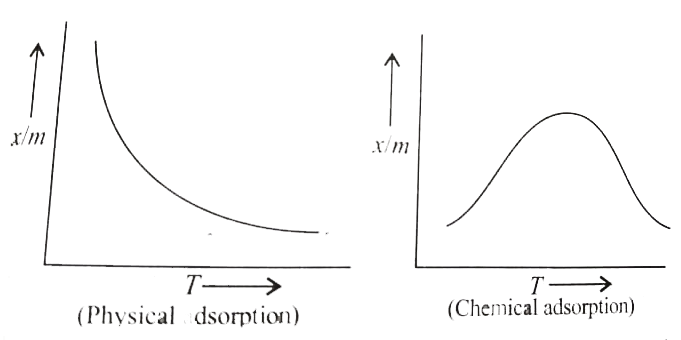Complete Solutions to Solved Examples of chapter SURFACE CHEMISTRY of Class 12 book with complete answers and questions
| Class 12 | CHEMISTRY |
| Chapter | SURFACE CHEMISTRY |
| CENGAGE CHEMISTRY | Solved Examples |
| Number Of Questions | 20 |
| Academic Year | 2023-24 |
What is the difference between multi-molecular and macromolecular colloids? Give one exarnple of each.
03:51View SolutionPhysical and chemical adsorption respond differenlty with a rise in temperature. What is this difference and why is it so? lt brgt

 02:41View Solution
02:41View SolutionA small amount of silica gel and anhydrous calcium chloride are placed separately in two corners of a vessel containing water vapour. What phenomena will occur?
02:26View SolutionHow is adsorption of a gas related to its critical temperature?
02:07View SolutionExplain the following observation:
a. Lyphilic colloid is more stable than lyophobic colloid.
b. Coagulation takes place when sodium chloride solution is added to a colloidal solution of ferric hydroxide.
c. Sky appears blue in colour.04:04View SolutionGive one test to distinguish whether the given emulsion is oil-in-water-type emulsion.
01:55View SolutionConsider the adsorption isotherm given below and interpret the variation in the extent of adsorption `(x/m)` when
a. Temperature increased at constant pressure.
b. Pressure increases at constant temperature.02:45View SolutionA colloidal solution of `Agl` is prepared by two different methods as shown in the figure below:


What is the charge of `Agl` colloidal particles in the two test tubes `(A)` and `(B)` ?
b. Given reasons for the origin of charge.02:03View SolutionAdsorption and Absorption are same. True/False?
02:35View SolutionAdsorption, if spontaneous, is exothermic. Explain.
03:19View SolutionIn a coagulation experiment, `5mL` of `As_(2)S_(3)` is mixed with distilled water and `0.1M` solution of an electrolyte `AB` so that the total volume is `10mL` . It was found that all solutions sontianing more than `4.6mL` . Of `AB` coagulate within `5` min. What is the flocculation value of `AB` for `As_(2)S_(3)` solution?
02:31View SolutionIn an adsorption experiment, a graph between log `(x/m)` versus log `P` was found to be linear with a slope of `45^(@)` . The intercept on the log `(x/m)` axis was found to be `0.3010` . Calculate the amount of the gas adsorbed per gram of charcoal under a pressure of `0.5` atm` .
03:44View SolutionThe volume of nitrogen gas `Vm` (at STP) reqired to cover a sample of silica gel with a monomolecular layer is `129cm^(3)g^(-1)` of gel. Calculate the surface area per gram of the gel if each nitrogen molecule occupies `16.23xx10^(-20)m^(2)` .
02:30View Solution`100mL` of a colloidal solution is completely precipitated by addition of `5mL` of `1M` `NaCl` solution. Calculate the coagulation value of `NaCl` .
02:36View SolutionWhat is the charge on the colloidal particles in the following ?
a. `Fe(OH)_(3)` sol
b. `As_(2)S_(3)` sol
c. Colloidal sol of sillver01:48View Solutionwhich of the following is most effective in coagulating ferric hydroxide sol?
a. `KCl`
b. `FeCl_(3)`
c. `Na_(2)SO_(4)`
d. `K_(3)[Fe(CN)_(6)]`02:30View SolutionWrite a mathematical expression showing relationship between the amount of solute adsorbed per unit mass of the solid adsorbent and the concentration of the solution in the solution.
02:06View SolutionIn the case of chemisorption, why adsorption first increases and then decreases with temperature?
02:37View SolutionWhy physisorption is multi-molecular whereas chemisorption is unimolecular ?
02:51View SolutionWhat happens when freshly precipitated `Fe(OH)_3` is shaken with small amount of `FeCl_3` solution ?
02:54View Solution
Solved Examples questions and complete solutions for chapter SURFACE CHEMISTRY of CENGAGE CHEMISTRY (ENGLISH) of Class 12
All Exercises from CENGAGE CHEMISTRY Class 12 CHEMISTRY SURFACE CHEMISTRY
- Archives Assertion-Reasoning
- Archives Fill In The Blanks
- Archives Multiple Correct
- Archives Single Correct
- Archives Subjective
- Ex 5.1
- Ex 5.2
- Exercises Assertion-Reasoning
- Exercises Fill In The Blanks
- Exercises Interger
- Exercises Link Comprehension
- Exercises Multiple Correct
- Exercises Single Correct
- Exercises Subjective
- Exercises True /False
- Illustration
- Illustration 5.36
- Single Correct Answer Type
- Solved Examples
